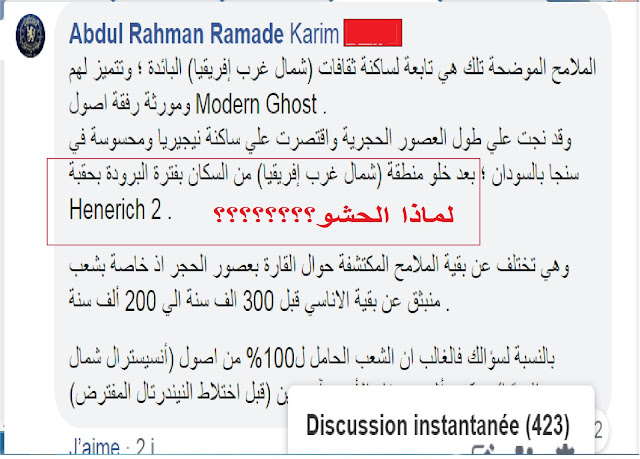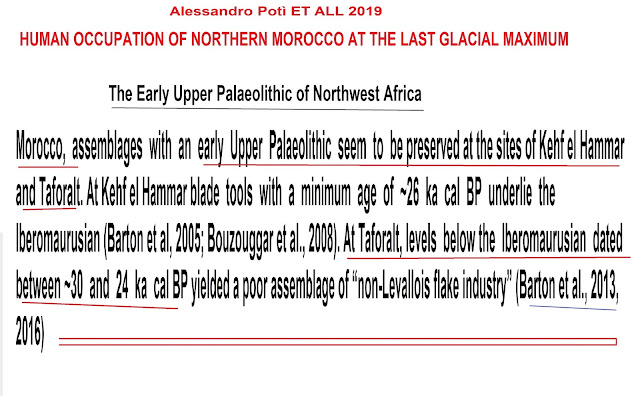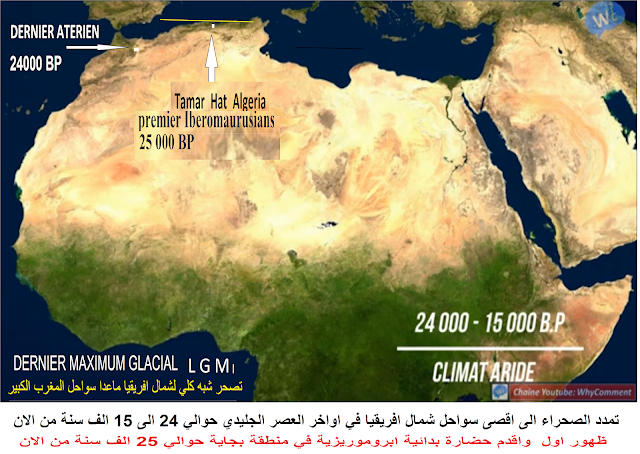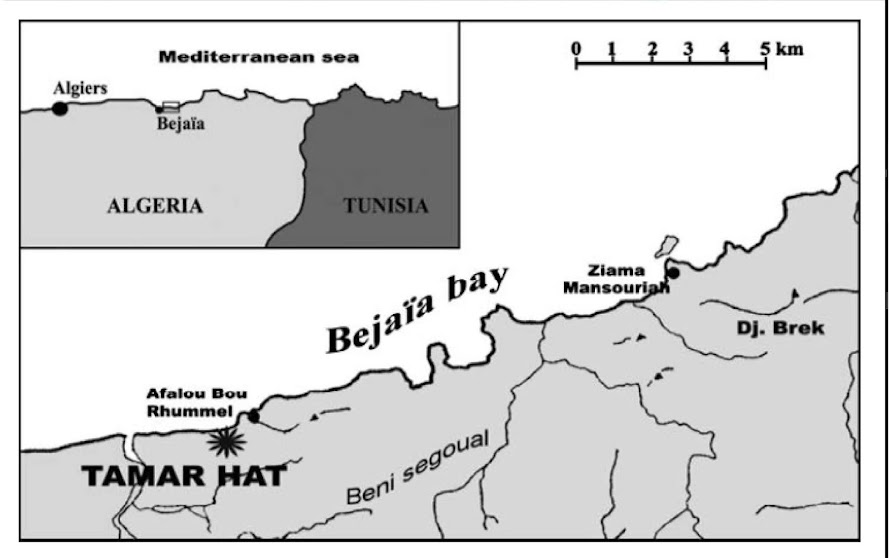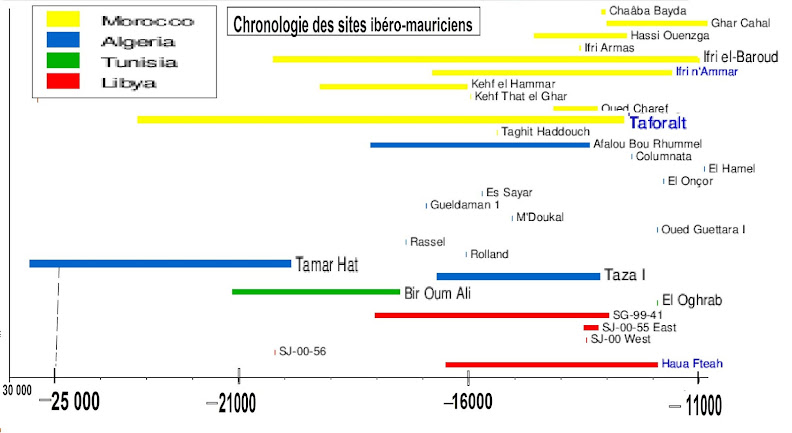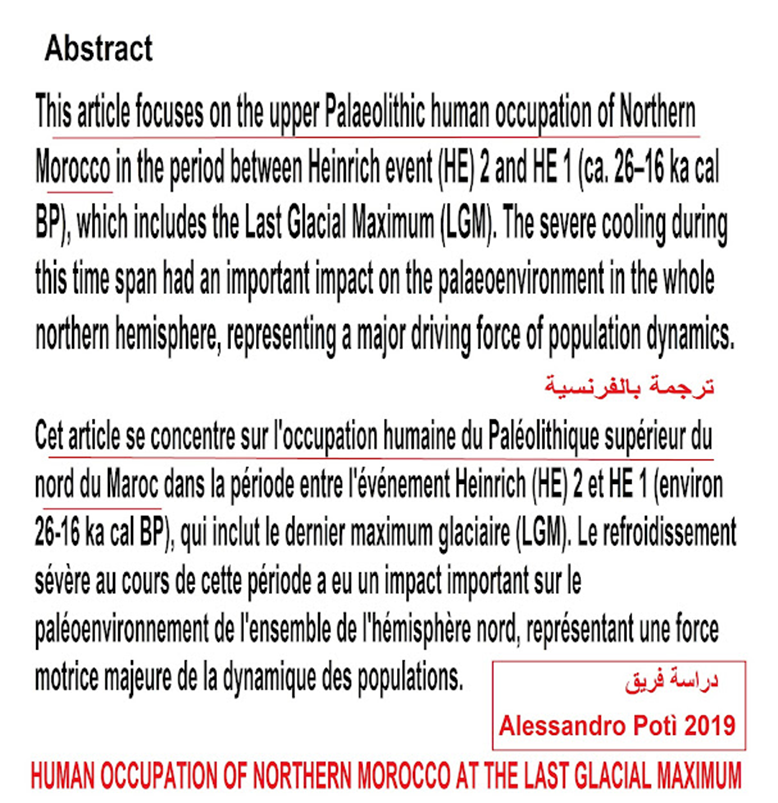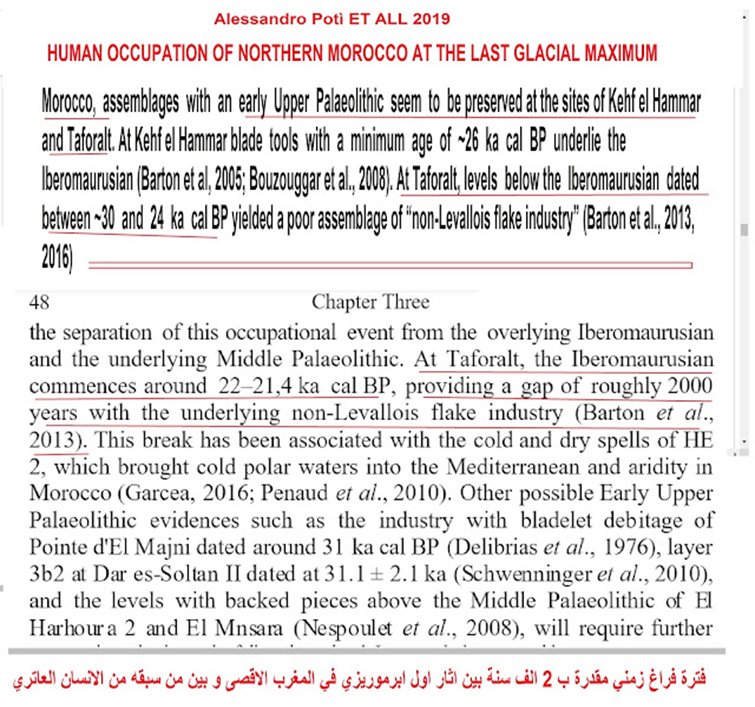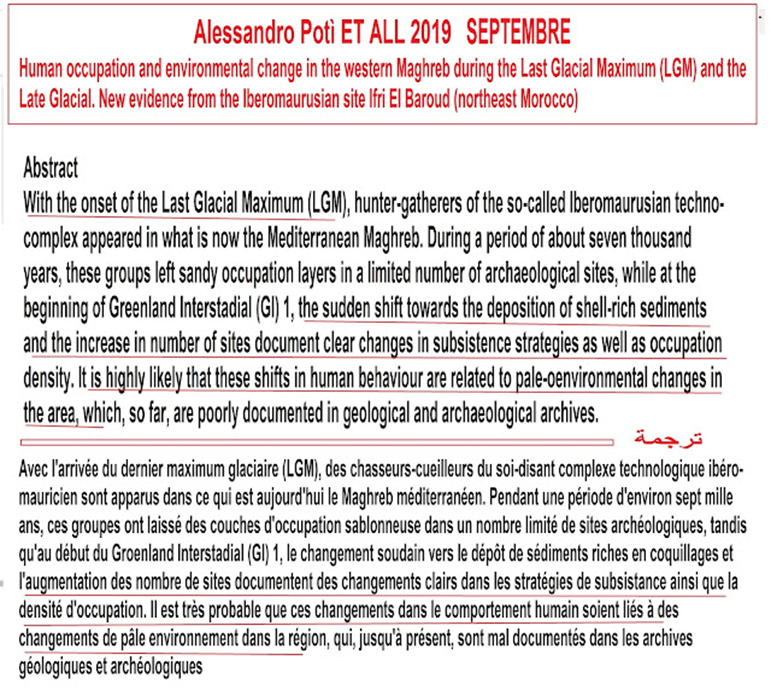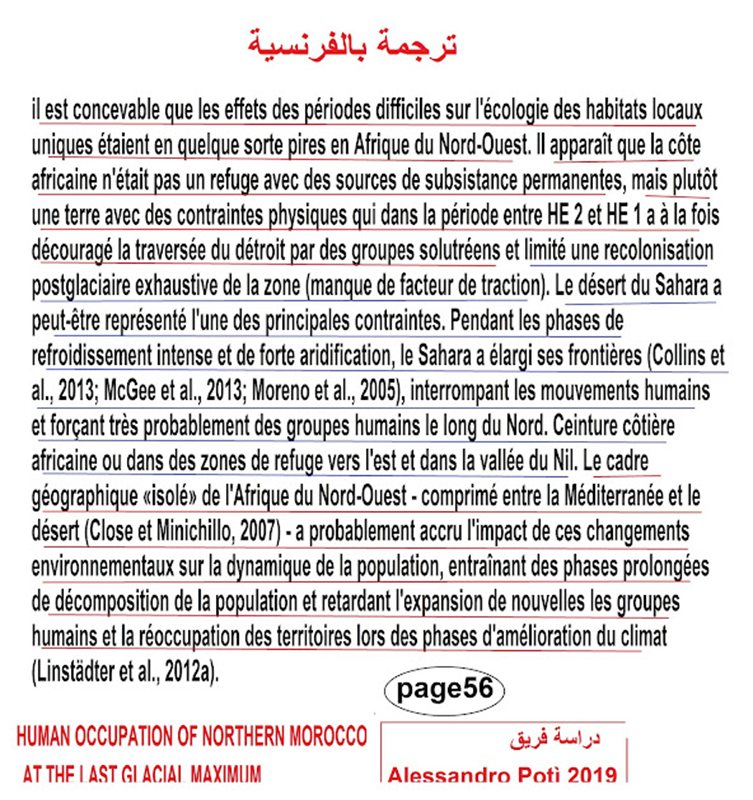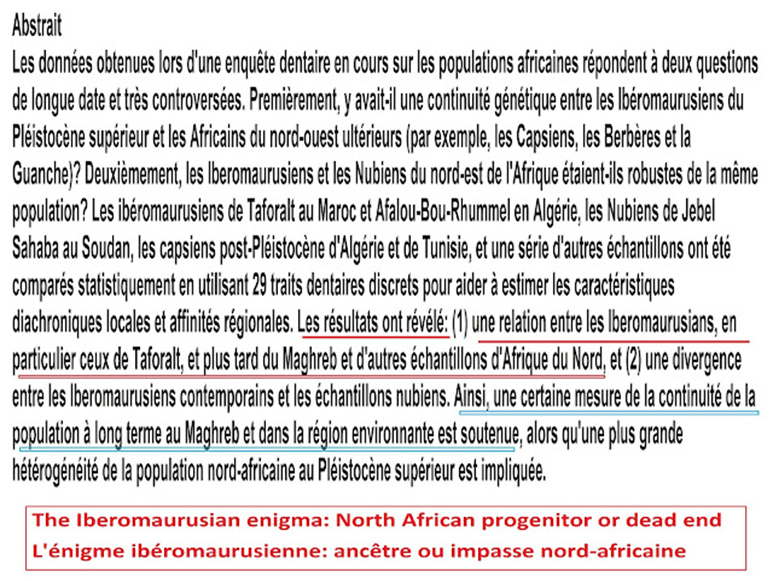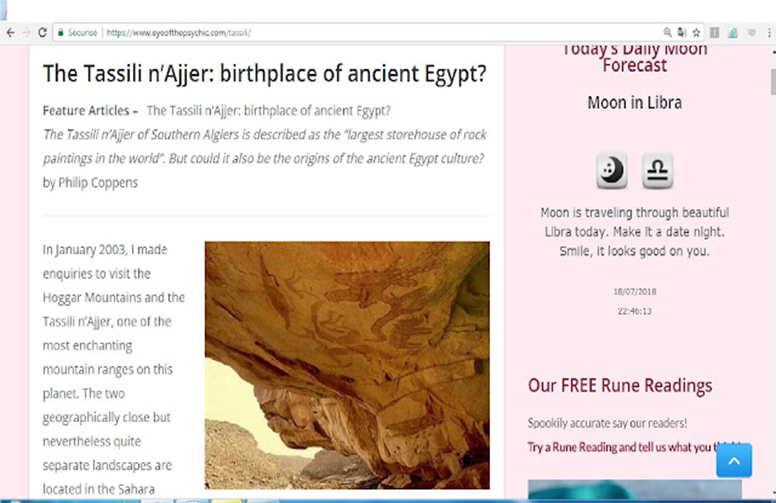Did humans become extinct in northwest Africa in the cold period of ?the Henerich 2
When fanaticism is mixed with science, the result is called the filler, and its name is in the Egyptian (Abd al-Rahman Ramad), and he is addicted to the page of the genome of the East.
The Great Middle East, which claims that humans became extinct from northwest Africa in the Heinrich II stage, i.e. between 22,000 and 24,000 years ago from Lan, which coincided with
The beginning of the last ice age. It seems clear that this talk of the Egyptian stems from a pathological tendency that some Egyptians suffer from by promoting the lie of Egypt, the mother of the world, and here they want to make Egypt the father of the world as well, through fabricating lies and blatant scientific fallacies that are intended to deny the relationship of the current inhabitants of Northwest Africa, or as we call them. The Berbers with ancient primitive civilizations, such as the Ataris, whose primitive culture appeared between 145,000 years ago, to the limits of 30 to 28 thousand years from now, and then came after them other cultures, such as the Abermoresians and Qafsians, which was scientifically and genetically confirmed. North Africa necessitated a response to its owners and revealed its fallacies as follows
And here is an excerpt from the speech of the Egyptian Mr. Abdel Rahman Ramad with an Algerian colleague who promotes the lie of the extinction of humans in northwest Africa at the end of the LGM ice age
This kind of confusion and filling is what we notice in the words of some enemies of the Amazigh history and the Maghreb, who insist on erasing any human continuity in the Maghreb to reach in the end to say that the Amazigh are not the original inhabitants of the Maghreb in the previous picture, an example from the page of the genome of the Middle East The great owner, Abd al-Rahman Ramad, whose only concern is to prove that the inhabitants of the Maghreb at the present time have nothing to do with the Ataris . DERNIER MAXIMUM GLACIALIn English LAST GLACIAL MAXIMUM
It is the period between about 25 thousand to 15 thousand years from now, and the beginning of this glacial period coincides with the beginning of the natural phenomenon called Henerich 2 Which is represented in the great breakage of the icebergs in the north of the globe and their gradual melting in the seas, which resulted in a change in the degree of salinity, the rise in sea level and a change in the global climate. This phenomenon, scientists estimated, occurred about 22,000 years ago, according to the study of Vidal et al. (1999 .)) and about 23 thousand years according to the study of Bond & Lotti (1995 .).) and about 24,000 years old, according to Hemming (2004 .).)
So, the natural phenomenon Heinrich 2 is confined between 22,000 and 24,000 years from now, and it corresponds to the beginning of the Upper Ice Age ( LGM ). It started 25,000 years from now to 15,000 years ago
Did humans become extinct in the Maghreb during this period of 22 to 24 thousand years, as some claimants claim?
The answer is simply no . This is stuffing, fraud, and talk in science mixed with ethnic fanaticism and selective talk from scientifically fallen studies through the latest archaeological discoveries of the oldest Abramorese civilization in the Maghreb
. And the way of life differs from one era to another according to the difference in nature and the availability of water, animals (games) and fruits. It is natural that climate change and desertification in northwest Africa have imposed on man to change his way of living and the tools used and even change the places where these characteristics are less
The Aterian culture in northwest Africa extended from about 145,000 or 175,000 years from now, according to the latest discoveries at the site of Omar Moussa in the Far Maghreb. The last traces of Aterian culture as recorded in the study of the archeology of the Wadi Noun region in southern Morocco, which was estimated at about 30 thousand and 900 years, according to the study of Wengler et al. 2010 and according to a previous study by Weisrock et al., 2006
The Maghreb man started from 30,000 years ago using other methods and tools of living that differ from the Aterian culture or technology, and the exact name for this culture, which came immediately after the Ateriya, was not specified. This stage continued until 24 thousand and 500 years from now in the Far Maghreb, especially in The Tavoglit site, then replaced them with a culture or a primitive technology and tools known as the civilization, the beginning of the Abermoresian , and this data is fixed in a scientific study that came out in 2013 by re-updating the chronological estimate of the age of the Aterian civilization at the site of Tavoglt, where the results gave the survival of this civilization up to 37 thousand years in Tavoglt and It was followed by a culture or a primitive technology different from the Ateria. A definition or a name for it has not yet been determined, but it indicates the continuation of human existence and in Tavoglt Cave until 24 thousand years from now , a study by a team . E.Barton
A.Bouzouggar2013
Origins of the Iberomaurusian in NW Africa: New AMS radiocarbon dating of the Middle and Later Stone Age deposits at Taforalt Cave, Morocco
Origines de l'Iberomaurusian en Afrique du Nord-Ouest: Nouvelle datation au radiocarbone AMS des dépôts de l'âge de pierre moyen et postérieur à la grotte de Taforalt, Maroc
Study link
https://www.sciencedirect.com/science/article/abs/pii/S0047248413001383
Quote from the study
This was confirmed by the study of the team Alessandro Potì2019
HUMAN OCCUPATION OF NORTHERN MOROCCO AT THE LAST GLACIAL MAXIMUM
OCCUPATION HUMAINE DU NORD DU MAROC AU DERNIER MAXIMUM GLACIAL 2019
paragraph
The Early Upper Palaeolithic of Northwest Africa
Study link
https://www.researchgate.net/publication/337567025_HUMAN_OCCUPATION_OF_NORTHERN_MOROCCO_AT_THE_LAST_GLACIAL_MAXIMUM
Quote from the study
Now we know that the Aterian culture that characterized the primitive man in North Africa was followed by human presence, culture and tools up to 24 thousand years ago, and this is at the site of Tafoglt and it confirms the human presence from the Atari period until 24 thousand years ago
, and after that came the so-called Abromourizi civilization, which is a civilization LAST GLACIAL MAXIMUM( LGMFrom 24 to 15,000 years from now, the desertification of North Africa was known completely, and the arid desert extended to the coasts of the Mediterranean, and the vegetation and vegetation remained only within a few kilometers from the coast of the sea, and this is what led to the exodus of humans from North Africa to the far south of the Sahara
And to the Iberian island and the rest of the people who lived in the far northwest of Africa near the coast of the sea, and this is to approach the cold regions that did not completely desertify, and their Ibermoresian civilization was named after the region of southern Spain, Iberia, and in relation to the North African region (Moorish)
A picture of the progress of the desert in the Ice Age LG M ( Henerich 2 )
This sudden and rapid climate change is what prompted the extinction of the Aterian civilization, meaning the extinction of the ways of living and tools that were used in the Aterian period, which depended on travel, hunting and picking fruits and led to the migration of the Ater man to many sites that are no longer suitable for living and their direction to Areas closer to the coast, such as the Mediterranean, and to high areas such as mountains, which are colder than desert plains. The
disappearance of primitive traces of Aterians from some areas in northwest Africa does not mean the extinction of humans in northwest Africa, as some say. The difference is only in the lifestyle due to climate change, nature and change of place, which was indicated by the study of researcher Elena Garcia issued in the year 2018 AD under
the title
l'adaptation atérienne entre sources d'eau et sécheresse
Which showed how the Ater man adapted to the harsh natural conditions (desertification) by changing his places, style and means of living
, a study
With the entry of the region into severe desertification and the extinction of animals and plants in most of Northwest Africa, most of its inhabitants were forced to migrate from it to other regions, but not all of them.
In the North African region, some people remained confined to the far north of the Maghreb, in an area extending from Skikda to Bejaia, where the presence of the first Ibermorese civilization began about 25 thousand years from now, and this is before the last traces of the Aterian civilization became extinct in the Far Maghreb at the site of Tafoglet about 24 thousand A year, as shown above, meaning that the Aterian civilization in the Far Maghreb remained in the same period as the Abermoresian civilization, i.e. coexistence for about a thousand years, which indicates that humans did not completely extinct from North Africa, as some deceivers claim. It began before the end of Al-Atria, which is 25 thousand years, and this is in the Bejaia region, the site of Tamarat
Humans gradually withdrew to the far northwest of Africa, especially the Bejaia region of Algeria, due to the expansion of the desert to the Maghreb region, and it completely touched the area or site of Tavogalt Al-Atari in the Far Maghreb. This is why life was cut off for a certain period and from desertification. The Maghreb, the Ibermoresian civilization in the Great Maghreb, began before the complete extinction of the Aterian civilization in the Maghreb
What is the oldest age and the oldest site of the beginning of the Ibermoresian civilization in North Africa
We mentioned the Tamhart Bejaia site, which is a well-known archaeological site, and it has been known for a long time.
Joshua T. Hogue Team Study 2016
Re-examination of the Zone I Material from Tamar Hat (Algeria) Zooarchaeological and Technofunctional Analyses
Réexamen du matériel de la zone I de Tamar Hat (Algérie): analyses zooarchéologiques et technofonctionnelles
https://www.researchgate.net/publication/294860531_New_radiocarbon_dates_for_the_earliest_Later_Stone_Age_microlithic_technology_in_Northwest_Africa
These archaeological data about the oldest Abermorian monuments in North Africa, estimated to be more than 25,000 years old, are also officially approved by biological researchers, that is, in genetic studies, including the study of the researcher Luesdrich for the year 2018, where he confirmed that the site of Tamarat in Bahia is more than 25 thousand years old from now . Study https://science.sciencemag.org/content/360/6388/548 Adapted from the study
Bejaia Tamarate website
Here is a link to a 2017 archaeological study on the way of life of the Abermorese man at the Tamarat Bejaia site 25 thousand years from now
Économie lithique et activités spécialisées parmi les populations ibéro-mauriciennes de Tamar Hat Rockshelter (nord-est de l'Algerie)
https://www.researchgate.net/publication/320990616_Lithic_Economy_and_Specialized_Activities_Among_the_Iberomaurusian_Populations_of_Tamar_Hat_Rockshelter_Northeastern_Algeria
The chronology of the Ibermoresian Archeology in Northwest Africa
So, through the archeological studies mentioned above, it becomes clear to you that humans did not become extinct at all between the period of the end of the primitive Aterian culture, about 30 thousand years, and the period of the Abramoris culture of 25 thousand years, that is, at the beginning of the last Ice Age ( LGM ). Because the Ibermorese civilization in Algeria, the site of Bejaia, began a thousand years before the extinction of the last civilization that came after the Ateria, which was present in Morocco at the site of Tafoglt and dated to 24 thousand years
. A year followed by the period of the existence of an unknown primitive human civilization until 24 thousand years and the emergence of the first Ambermorese civilization about 25 thousand years that there was no human extinction in northwest Africa with the evidence of human presence in all these times
With these new data, we close the curtain on the confusion that exists on the part of some malicious people about the lie about the extinction of human beings in the Maghreb in the period of 22 to 24 thousand years, and the topic does not accept the slightest discussion or hint
It is worth noting that the discontinuity between the Atri and the Abramurizi, which is promoted as covering all of Northwest Africa, according to the study of Alessandro Potì 2019 took place only in the Al-Aqsa Maghreb in the Tafoglet site, and not all of the Maghreb, as some want to mislead by saying that it included all of Northwest Africa.
As indicated by the archaeological studies on which the team of Alessandro Potì . relied2019 (November), which was limited to speaking only in the Far Maghreb. The site of Tafoglit. Regarding the void between the Aterian and the Immorizian civilizations, a human presence and an unknown culture were found among them. It was
estimated at the Tafoglit site that the human void was only about 2 thousand years old, and this is normal because the Tafoglit area is on a remote level. On the coasts of the Mediterranean, it was subjected to a large desertification and is no longer livable with the absence of plant and animal life, which was the basis of the life of the hunter-gatherer man . Generalizing it to all of North Africa in which humans remained here and there in different locations and times without total extinction, as some claim in the following study
HUMAN OCCUPATION OF NORTHERN MOROCCO AT THE LAST GLACIAL MAXIMUM
Where we warn readers that this is the vacuum period that the semi-researchers are trying to falsely promote that it pertains to all of North Africa. Today without interruption in some areas of northwest Africa,
and here we are talking, for example, on the site of Abermorezi Atri in the green mountain, the site of Al-Dabbaneh in northern Libya, which is an ancient home of the Berbers and their ancestors, where the study of Alessandro 2019 confirmed the human continuity in this site without interruption
Quote from the study
The original text is in English
With regard to the change in the nature of the archeology between the Aterian man and the Maghreb Abermorian man, it is due to the rapid and sudden change of the climate and the encroachment of the desert to the far north of the Maghreb, which led to the confinement of humans to the far northern coasts (Bejaia districts) and with the lack of plants and animals these conditions were imposed on him in The beginning of the last ice age, starting from 25 thousand years ago, new ways of living and resistance to very harsh climatic conditions, and this was indicated by second archaeological studies of the Alessandro Potì team2019 (November)
Human occupation and environmental change in the western Maghreb during the Last Glacial Maximum (LGM) and the Late Glacial. New evidence from the Iberomaurusian site Ifri El Baroud (northeast Morocco)
https://www.researchgate.net/publication/334989434_Human
Quote from the study
as the aforementioned study of Alessandro in November 2019 confirmed that people in northwest Africa have greatly reduced their number due to the dry climate and desertification, which extended to the far north and expanded the Sahara and became a great barrier to the movement of people from it to the south of the Sahara or to the east of the continent via The Sahara, and this is at the beginning of the last ice age LGM, about 25,000 years ago, and the study adds that the Northwest African region in this period was not encouraging for any movement to it, whether from Europe from the Iberia Island in Spain or from sub-Saharan or from East Africa, and this part of the world became isolated from The rest of the world for a long time and vice versa, according to the study, the population of northwest Africa is the one who gradually moved to the south of the Sahara and to the Nile area in Egypt before desertification intensified completely, and this is through the Mediterranean coast and across the surrounding coast in the direction south of the Sahara. Quoted from the study
French translation
In general, the descendants of the Ebermoresians continued and spread strongly in the north of the Great Maghreb and the Sahara, after the end of the last ice age LGM .24 thousand to 15 thousand years From 15,000 years ago to about 5,000 years ago, the ice melted in the north of the globe and resulted in a change in the world’s climate, and the Sahara desert experienced great greenness due to a large increase in the proportion of rain and humidity, especially about 11 thousand years, and from this the spread of animals as shown by the effects of Tassili, which prompted humans to appear in it in abundance, as some studies showed that the antiquities in the Sahara Desert are more than 8 thousand years old.
The emergence of tropical life and animals in the time of the greenness of the desert 15 thousand to 6 thousand years, needing water as much as the elephant, and this is in the Sahara
Archeological human continuity in the Maghreb from the Abromourizi to the Berbers
After the Abermoresian civilization came the Maghreb cage culture, and many anthropologists and archeologists emphasized the human continuity from the Abermoresian to the Cafsiah to the Berber people, the inhabitants of the Maghreb, including the study of
The Iberomaurusian enigma: North African progenitor or dead end
L'énigme ibéromaurusienne: ancêtre ou impasse nord-africaine
This archaeological study is added to several genetic scientific studies that confirm human continuity from the Abermorese man, such as the remains of Tavogalt, which is 15,000 years old, until the remains of a human Omar Musa, about 8 thousand years old, until the current Berbers, for example, the Berbers of the Mzab of Algeria. These three elements carry what The ancient genomes of Northwest Africa are known, and they are 100% identical between the Maghreb-Amerorese Tavoglit man and the Neolithic age-man of the Neolithic period . Link to the study
https://www.sciencedirect.com/science/article/abs/pii/S0047248400904305?via%3Dihub
And in the end, we say, the Egyptian Facebook page, the genome of the Great Middle East, this desert civilization from Tassili is the civilization that was the origin of the ancient Egyptian civilization
See the research that confirms that the Tassili civilization in the Algerian desert is the origin of the Egyptian civilization
The Tassili n'Ajjer: birthplace of ancient Egypt?
search link:
https://www.eyeofthepsychic.com/tassili/
http://origineamazigh.blogspot.com/2020/02/henerich-2.html



